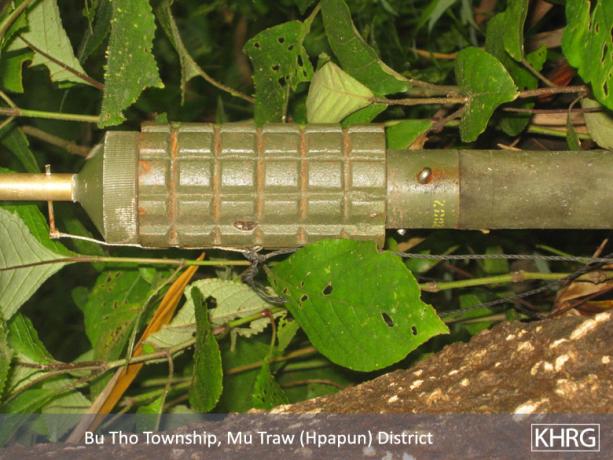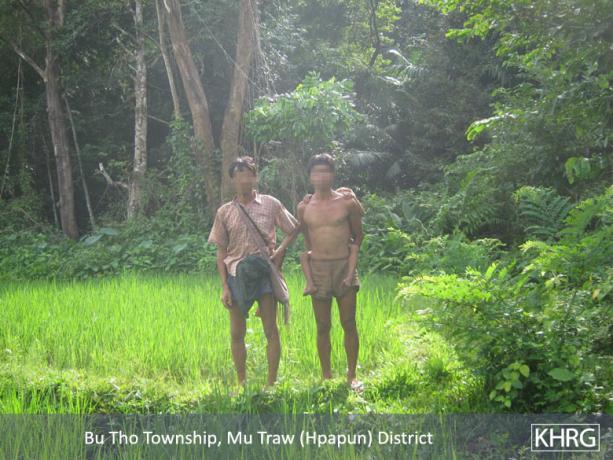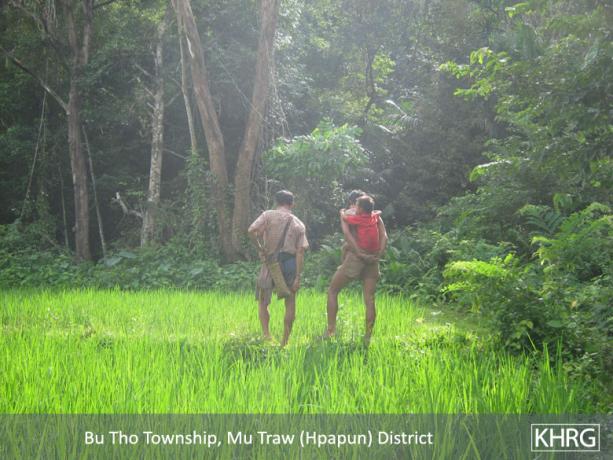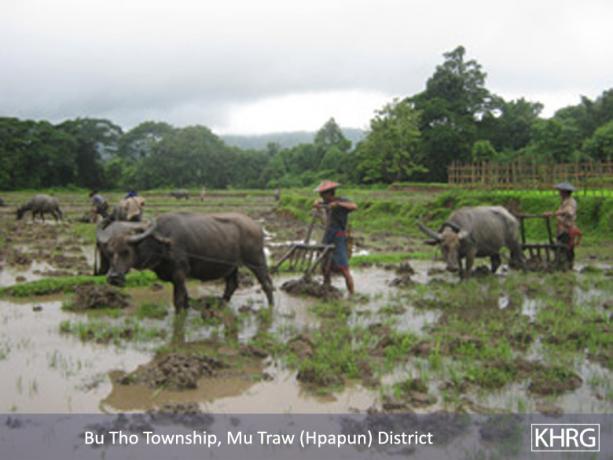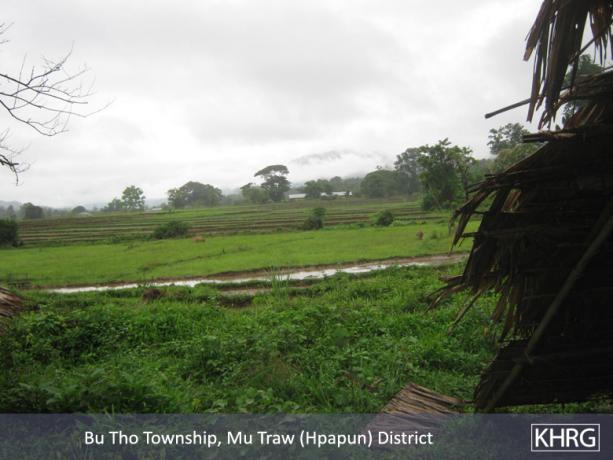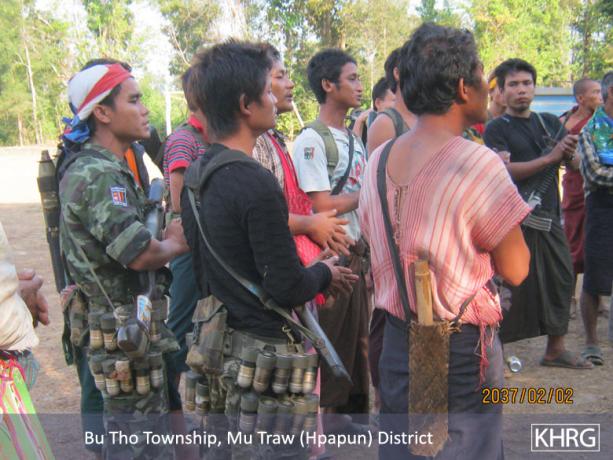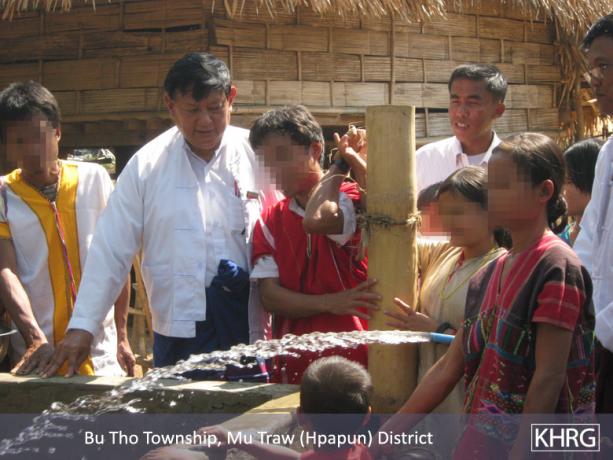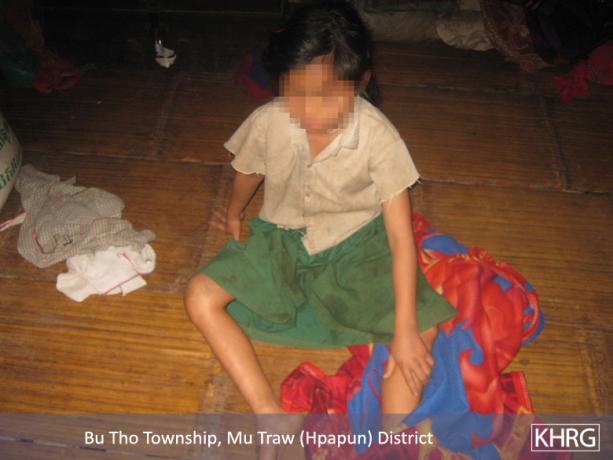This report includes a situation update submitted to KHRG in April 2012 by a community member trained by KHRG describing events occurring in Bu Tho Township, Papun District, prior to April 2012. It contains updated information concerning an increase in Tatmadaw and Border Guard military activity since the January 2012 ceasefire agreement with the KNU, including more frequent transportation of rations, building materials and weapons, and an increase in troop deployment. It describes how Tatmadaw LIB #341, #434, #340, and #642 have established permanent bases by the Papun vehicle road, and how troops reportedly remain stationed at numerous bases along the Thailand-Burma border. Land confiscation for infrastructure projects and the construction of military bases and plantations is highlighted as a significant issue, and continued natural resource extraction also serves to limit the amount of cultivatable land available. State-led development projects at the village level are also cited as contributing to land confiscation as a result of demands for land from government officials involved. Information is also provided on the construction of a new village in Meh Pree Township by a monk in command of approximately 20-30 soldiers. Villagers continue to face demands for food and goods, such as thatch shingles, and demands for forced labour. Significantly, demands for money, or for villagers to serve as soldiers and guides or to perform sentry duty, has reportedly ceased, and there has been a reduction in travel restrictions since January 2012. Some limited landmine clearance is reported to have occurred after villagers discussed the problem with a Tatmadaw officer. Other villagers have adapted to the reduction of suitable farmland by trading livestock and transporting food to sell. Villagers also refused to comply with demands for land in exchange for electricity, and confronted officials over the issue.
Situation Update | Bu Tho Township, Papun District (received April 2012)
The following situation update was written by a community member in Papun District who has been trained by KHRG to monitor human rights conditions. It is presented below translated exactly as originally written, save for minor edits for clarity and security.[1] This report was received along with other information from Papun District, including 13 interviews, one other situation update and 325 photographs.[2]
Military activity
The Tatmadaw and armed groups, including the Border Guard and the DKBA [Democratic Karen Buddhist Army], are active in the area now. The KNLA [Karen National Liberation Army] is especially active in the area. They have had to actively protect the civilians to help them to survive and so that they can avoid doing forced labour for the Tatmadaw. The KNLA has taken responsibility for protecting the civilians.
I do not know the Burmese army [Tatmadaw] officer's name and I am not sure if I can find out. However, their camp is based to the east of the Pgeh Loh River, where IB [Infantry Battalion] #19 and LIBs [Light Infantry Battalions] #341, #434 and #340 are based. There is also one other battalion. I do not know their commander's name, but their battalion number is #642. They [the Tatmadaw] have based these five battalions in camps alongside the Papun vehicle road all the way to Way Moo village. I would say that their camps are permanent.
There are other army camps based along the border [with Thailand]. These camps are located on the Khoh Nee riverbank from Hkaw Poo to Pa Heh, K'Hee Kyoh, Kyaw Nya, Dah Kway, U Thoo Hta, Meh Ra Hta, Meh Paw Muh Hta, Thee Roh Hta, Moh Moo Kyoh and Thoo Mgeh Hta [villages]. There is also another army camp in the Meh Pa area. These army camps have been based along the border for over ten years, but I cannot tell if they have been set up for temporary purposes or if they have been set up permanently.
Border Guard Battalion #1012 is based in Oh Daw, Battalion #1013 is based in Hpaw Htee Hkuh, and Battalion #1014 is based in Tha Aw Play. I do not know for sure whether these three battalions are active or based there permanently. The commander of Battalion #1012 is Hpa Bee. The commander of Battalion #1013 is La Kyeh, and the deputy Commander is Kyaw Way. I do not know the name of the commander of Battalion #1014.
The [Burma] government has increased troop numbers [in the Karen districts]. I asked [the villagers] how many battalions and camps there were, but I did not find out. The Tatmadaw's activities have included the transportation of food and weapons. It seems like more food and weapons are being transported [by the Tatmadaw] at present than in previous years. The Tatmadaw has not only sent food, but has also sent iron and cement for constructing many buildings. I do not know how many soldiers currently guard the gates at the entrance of the camps. Sometimes there are two to four soldiers.
The villagers have not responded to the situation reported above. The situation means that the Government army [Tatmadaw] has increased [in Karen districts] in order to ensure their security when transporting food between Ka Ma Maung and Papun, and between Papun and the Khoh Nee riverbank. They have sent more food and weapons than in previous years because they have agreed to a ceasefire with the KNU [Karen National Union]. The Tatmadaw are now able to send materials and equipment more freely, so they have sent and stored a lot of supplies. They will be more capable of operating if fighting happens again. I think that the Tatmadaw will use the materials that they have stored, such as iron and cement, to repair their camps in Papun town and buildings in other camps.
800x600 Normal 0 false false false EN-US X-NONE LAO /* Style Definitions */ table.MsoNormalTable {mso-style-name:"Table Normal"; mso-tstyle-rowband-size:0; mso-tstyle-colband-size:0; mso-style-noshow:yes; mso-style-priority:99; mso-style-parent:""; mso-padding-alt:0in 5.4pt 0in 5.4pt; mso-para-margin:0in; mso-para-margin-bottom:.0001pt; mso-pagination:widow-orphan; font-size:10.0pt; font-family:"Times New Roman","serif";}
The police have rebuilt the police station in Papun [city]. They have repaired it and the number of police officers has also increased, but I do not know the leader’s name. I do not know any more about the fixing of checkpoints and I do not know about the camps that were abandoned, as people do not use them anymore. Regarding the existing army camps, the Tatmadaw planted landmines beside them and also on the mountains in the past. They also planted it beside villagers’ flat fields, and the places where villagers travel to cut trees and bamboo. Regarding checkpoints, I know that since January 2012, citizens have been able to travel more freely.
Landmines
With regards to the situation reported above as it relates to landmines, civilians were able to respond in only one way. The village head and knowledgeable villagers went to tell the [Tatmadaw] officer that the villagers needed to build houses. The villagers have to feed their buffalos, so some Tatmadaw battalions have allowed the villagers to use some places beside the flat field farms [by clearing some of the landmines]. The situation is such that if the KNLA were to go on patrol, they would be in danger of being hit by landmines. If the KNLA patrols near the Tatmadaw camps that are beside the flat field farms, they could step on the landmines when they are going back. The Tatmadaw did this [planted landmines] to protect themselves. But in my opinion, it was to make things difficult for the villagers to work. I also think that the Government army thought that the KNLA would not know the path, so if they [the KNLA] want to go to their [Tatmadaw] camps they might ask the villagers to accompany them [to show them where the landmines are] and the villagers could be hit too. This is what I think.
I do not know what the Tatmadaw soldiers do when they are in the camps. Sometimes, they stay in the army camp, but other times they patrol outside. They go out [of their camps] to guard the bulldozers. We do not know what kinds of food they have demanded [from villagers]. The Tatmadaw has demanded coconuts and vegetables from the villages of K--- and M---. They do not demand money, porters, or villagers for sentry duty or to serve as soldiers, and they do not order villagers to serve as guides for them anymore. However, they still order thatch shingles. We do not know the name of the officer from the battalion [LIB #340] that orders things from the villagers. LIB #340 still orders villagers to do work, such as helping them to plough fields, plant paddy, and to winnow in C--- village. However, I do not know the officer's name. The civilians have not prevented this situation from happening. They have followed the demands as much as they could, but they have not followed all [of the Tatmadaw's] orders. These situations mean that human rights abuses continue. In my opinion, they [Tatmadaw soldiers] have not paid the villagers for their work such as ploughing fields, planting paddy and making thatch shingles. As they [the soldiers] have a salary, it is better if they pay for things like that.
Since January 2012, I have not seen the villagers respond to the fighting that has happened between the two armed groups [the Tatmadaw and the KNLA]. Regarding the planting of landmines, since the ceasefire the villagers have planned to clear landmines from their workplaces in order to work more easily. The armed groups that were active in the area have cleared some of them. The villagers have not responded to this situation. The villagers' workplaces have been cleared [of landmines] because of the ceasefire [between the Tatmadaw and the KNLA].
Land confiscation and livelihoods
The powerful groups that came [to confiscate land], and caused problems and damaged the villagers' livelihoods day by day were the Border Guard and Burmese government army [Tatmadaw]. The Burmese government army has damaged the villagers' land and livelihoods by building camps on their land. The land that has been taken is on both sides of the vehicle road from Papun city to Way Moo Way Hsa [village]. A lot of land has been destroyed, but I cannot report the exact amount. From the [November] 2010 Burma election until March 2012, they [the Tatmadaw] built one new section in the Traw Day area of Papun city. The civilians have not responded to this situation. This situation [of land confiscation] is a human rights abuse. In my opinion, the Burmese government has a salary and money so it should not commit human rights abuses.
The powerful people [Burma government] built a vehicle road, camps, and rubber plantations that have impacted the villagers negatively. The Tatmadaw did development projects in Papun city, such as building a battalion camp, which required the confiscation of the villagers' land on both sides of the vehicle road from Meh T'Roh to T'Koo Teh. A lot of land was damaged, but I cannot report how much exactly. There are no travel restrictions and no mining, but the Burma government came to measure villagers' land, and confiscated it. Other things have also happened, like demands for land for small rubber plantations in E--- [village] after the Burma government set up electricity in the village for the villagers.
The villagers responded in some ways to the situation [relating to the confiscation of land for development projects] reported above. With regards to the setting up of electricity in the village and the demands for land, they replied that they could not give them the land because they earn their livelihoods by farming flat fields and hill fields. If they were to give the Burma government the places that they demanded, they would not have any land to farm hill fields,and the amount of land available to farm would become far less. This situation [of land confiscation] is a human rights abuse, and the civilians are forced into it. These demands are illegal. That is my opinion.
The opportunities that the villagers have to earn their livelihoods through agriculture, transporting goods, trading, hunting animals and finding food in the forest has changed. They still have a chance to do these things; however, it is not enough. The villagers have not responded in any way to this situation. They have just worked where they could work. They do not work if they cannot work. The situation is such that some villagers live far from the vehicle road and some villagers do not live where people [the Burma government] are doing development projects, so they can still do agriculture.
Villagers' livelihoods are changing because of natural resource extraction, which has decreased the natural places available [for farming]. For example, the extraction of natural resources damages all of the important cultural places, fresh water, fresh air, the forest, mineral resources, land, and the places where animals live and villagers hunt. As a consequence, some people's livelihoods are not the same. The villagers have not responded in any way to this situation [natural resource extraction]. This situation has meant that some villagers now plant peanuts and some trade animals for their livelihoods. Some villagers carry food to sell, and some farm flat fields and hill fields.
Changes in health
The villagers' health has changed and there has been an increase in new diseases such as dizziness, hypertension, malaria, and body pain. If the villagers go to the government hospital, they have to pay money. There they do not ask for payment for the cost of the treatment. They are willing to help, but people have to pay upwards of 5,000 kyat (US $6.11).[4] They do not take responsibility for caring for the villagers' health. The government confiscates all things used for the prevention and treatment of disease if they see villagers carrying them. Peoples' use of traditional medicine has decreased because diseases have increased and the demand for medicine has also increased, so people cannot use traditional medicine anymore. The villagers could not respond to this situation in any way, so they have had to follow whatever people [at the government hospital] order them to do. I cannot tell you any more about this situation.
Changes in education
Because teachers have not attended school regularly, the students' standard of education has been affected. Their salary has increased, which has caused problems for the student's parents. The Karen language is not taught in every school, particularly in the schools that are controlled by the government. Some schools in Ph---, La--- and Y--- have been closed. These schools have been closed since July 2011 because the Burmese army active in the area came to sleep in the villages and fired heavy weapons and people were afraid and fled. Even now, people have not gone back to those villages, so the schools were closed. These schools are in Htee Th'Daw Hta village tract. These schools were not able to teach the Karen language because the teachers had graduated from the Burmese government's school. People who want to go to study at high schools in Burma have to change their names to a Burmese one so that they can go and study there. After they have graduated, they have to use a Burmese name in order to get a job.
The villagers could not respond to this situation [concerning education] in any way. People [from the Burma government] have forbidden them to respond. In schools that are far from the Burmese government and near to the areas under KNU control, even in those that people recognise as Burmese government schools, the villagers can respond by teaching the Karen language. This situation means that the Burmese government wants to kill the Karen culture and language through education. That is my opinion.
Changes in the situation for women
There is no more rape or torture.[5] There are no difficulties preventing women from accessing health care when giving birth. Healthcare is getting a little bit better. Women still have to do forced labour, but it has reduced a little bit. There are still livelihood difficulties. Even though men work to earn their livelihoods, it is not enough so women also have to work. Even though there are much better opportunities for women [than before], it is difficult for them to access education and to look after their families.
Cultural [and religious] freedoms
The opportunity for freedom of expression is getting a little bit better. There are no restrictions on religious worship. Cultural freedoms are getting a little bit better. Villagers can meet and communicate well. There is no more forcing of people to enter the religion [Buddhism] in order to get an education. The villagers have not responded to this situation. This situation means a reduction in the restrictions on accessing education.
The Border Guard does not have a base in this area [Bu Tho Township]. Their nearest base is in Hpaw Htee Hku camp. This is Battalion #1013, led by [Commander] Hla Kyaw and Second Commander Kyaw Way. They are active in the Bu Tho area.
In the Meh Pree area [village tract] of Bu Tho Township, a monk called Hkay Maw Way, also known as Hkay Mee Ka, lives with his soldiers. He has over 20 soldiers, approximately 30. He also has big weapons and small weapons. He lives between Meh Pree and Kyoh K'Loh and he has built a lot of rubber plantations. Moreover he has built one monastery and a school too. He plans to build a new village between Meh Pree and Kyoh K'Loh [villages], beside the monastery and road. He plans to dig one well for every two houses because the village [he plans to build] is far from water. He is carrying out his plan.
We do not know what monk Hkay Maw Way, also known as Hkay Mee Ka's, plan is, but it seems that the villagers in the Meh Pree area support him very much. We don't know what they [the monk and his soldiers] will destroy or how they will abuse the villagers' rights. We do not know which villages this monk will take people from for his new village. He wants to build the village in a rubber plantation. He has named this place Htoo Wah Kaw Kaw Kloh, but this place was not called this in the past. I do not know what it was named in the past. He plans to build a school and hospital in this village where civilians will not need to pay fees. However there is one thing: the civilians have to clear vegetation from his rubber plantations when he asks. People do not know where this monk has received assistance and money from; he just goes back to Kaw Taw and travels to Pa'an city.
The civilians have not responded in any way to this situation, reported above. They have just followed the plan of monk Hkay May Way, also known as Hkay Mee Ka. Regarding this incident, I think that it would be good if the monk were to do good things. If he works for the Burmese government and follows their suggestions, it would seem that the civilians who live nearby would be affected in a very negative way. It would affect them by preventing them from farming their hill fields or working in agriculture anymore. It would affect the villagers who farm hill fields, particularly those who do not eat enough, because the monks' village only has rubber plantations nearby. That is my opinion.
Burma government development projects
The Burmese government came to C--- village to carry out development projects, including building a school. They provided two teachers, but they only taught for one or two months and then they left and could not be found. There is only one person, [a teacher] who the villagers selected, left [at the school]. They [the teachers provided by the government] did not help the teacher chosen by the villagers, but the villagers struggled by themselves. This school is classified as a government school. They built this school in C--- village in June 2011.
On February 3rd 2012, they [Papun district Saw Mya Htunt Way and government officials] came to C--- village to provide electricity from a hydroelectric source. They also provided pipelines that carry water to the village. After that, the villagers had to give one goat and one pig to the Papun district leader Saw Mya Htunt Way and the government officials from Papun when they came to look at the village. One goat costs approximately between 15,000 - 20,000 kyat (US $18.34 - $24.45) and one pig costs over 100,000 kyat (US $122.25). I do not know the actual cost [of the animals that were provided]. I see that this kind of help is not always beneficial for the civilians. Regarding the hydroelectric energy, the rainfall differs between the summer and the rainy season, so it will be destroyed if people are not responsible.
[In another incident] they [the Burma government] provided electricity in E--- [village] but they [the villagers] said that the person [in charge] who came to help set up the electricity asked for 7,000 kyat (US $8.56) per house. There are 40 households in E---. This person also asked the villagers to provide them with one piece of land for a rubber plantation and for building his house on so that he could take responsibility for the electricity. But this would cause the villagers problems, so they told him that they couldn't be held responsible for any trouble or problems that arose. The villagers responded by saying that if he planted rubber trees they wouldn't be able to help him if he faced problems, so the introduction of electricity to E--- has not run smoothly for the civilians. The villagers are not able to keep buying bulbs for the fluorescent lights. One fluorescent light bulb costs 3,500 kyat (US $4.28), but they could only use it for one week before it became damaged so it does not benefit the civilians.
These four photos were taken in September 2011 in Bu Tho Township, Papun District. The top photos show a Burmese-made MM-1 stake fragmentation mine planted beside a flat field paddy farm, close to C--- village. According to a C--- village representative, the landmine was planted by Tatmadaw LIB #340 soldiers during September 2011. The owners of the flat field, next to which the mine was planted (shown in the bottom two photos with a child), told the community member who took these photos that they worried that their cows and buffalos would step on the mine and, as a result, had to keep an especially close watch on them. [Photos: KHRG]
These photos show C--- villagers forced to cultivate farmland for Tatmadaw troops in 2011. The top two photos, taken on July 19th 2011, show C--- villagers in Meh Klaw village tract ploughing farmland for LIB #340. The villagers did not receive any payment for this work, which the village representative from C--- described as the “oppression of the civilians”. The bottom left photo, also taken on July 19th 2011, shows the farm where C--- villagers had to plough and plant paddy during the rainy and summer seasons. The photo on the bottom right, received by KHRG on April 24th 2012, shows female C--- villagers planting paddy in Meh Ta Roh farm in December 2011 for Tatmadaw troops; villagers again received no payment and were not provided with any rice. In this photo, women are clearly visible, suggesting that Tatmadaw troops still rely on female villagers for some types of forced labour. [Photos: KHRG]
The photos above show Y--- school, left, and La---school, right, which remained closed as of May 2012, following the firing of mortars in Htee Th’Daw Hta village tract by Tatmadaw troops in July 2011. These photos were taken on January 14th 2012. [Photos: KHRG]
The photos above were taken on January 11th 2012 , and show villagers meeting with Monk Hkay Mee Ka in the field where the villagers celebrate the Karen New Year, between the villages of Meh Pree and Kyoh K’Loh, in Meh Pree village tract. Villagers met with the monk and some of his DKBA soldiers in order to become better acquainted with one another, as Monk Hkay Mee Ka is presently constructing a new village called Htoo Wah Kaw Kaw Kloh in the area where the meeting took place. [Photos: KHRG]
These photos, taken on February 11th 2012, show C--- villagers near a hydroelectric-powered well, top, built as part of a government development project and the broken cement, middle, after the well collapsed on February 12th 2011. A 12-year-old-girl retrieving water from the well was injured on her leg when the bricks collapsed. [Photos: KHRG]
These photos, taken on February 11th 2012, show C--- villagers preparing one goat, left, and one pig, right, for Burma government members from Papun District when they visited to set up a hydroelectric energy source in C--- village, Papun District. [Photos: KHRG]
The photo above, left, was taken on February 11th, 2012 in C--- village, and shows pipes used as part of a Burma government development project introducing hydroelectric power in C--- village. The photo above right, taken on the same day, shows Papun District leader Saw Mya Htunt Way, pictured right in the blue longyi, observing the process of setting up the electricity supply in C--- village. [Photos: KHRG]
These photos, taken on February 11th 2012, show Burma government members from Papun District when they came to introduce a hydroelectric power supply in C--- village. They arrived in C--- village with a famous Burmese doctor, left, and two nurses, right, to provide medical treatment and medicines. [Photos: KHRG]
Footnotes:
[1] KHRG trains community members in eastern Burma to document individual human rights abuses using a standardised reporting format; conduct interviews with other villagers; and write general updates on the situation in areas with which they are familiar. When writing situation updates, community members are encouraged to summarise recent events, raise issues that they consider to be important, and present their opinions or perspective on abuse and other local dynamics in their area.
[2] In order to increase the transparency of KHRG methodology and more directly communicate the experiences and perspectives of villagers in eastern Burma, KHRG aims to make all field information received available on the KHRG website once it has been processed and translated, subject only to security considerations. As companion to this, a redesigned website will be released in 2012. In the meantime, KHRG's most recently-published field information from Papun District can be found in the Report, "Sustained Tatmadaw resupply operations in Thaton, Nyaunglebin and Papun during ceasefire," KHRG, May 2012.
[3] These photos were previously published by KHRG in May 2012 in the report, Uncertain Ground: Landmines in eastern Burma.
[4] As of June 10th 2012, all conversion estimates for the kyat in this report are based on a rate of 818 kyat to US $1. This reflects new measures taken by Burma's central bank on April 2nd 2012 to initiate a managed float of the kyat, thus replacing the previous fixed rate of 6.5 kyat to US $1.
[5] This is an opinion expressed by the community member who wrote this report; it does not reflect KHRG's organizational understanding of the scope or scale of sexual violence or other abuse against women in eastern Burma. Community members trained by KHRG have previously gathered detailed evidence of specific incidents of rape and sexual violence by Tatmadaw soldiers; see Displacement Monitoring Update No. 39: "Body of unidentified naked woman found near Waw Lay village," KHRG, January 2011; Displacement Monitoring Update No. 48: "Interviews with Tatmadaw deserters confirm earlier reported incidents of abuse and general threats to civilians," KHRG January 2011. During 2011, KHRG received reports of rape and sexual violence requiring further confirmation from Papun, Thaton, Toungoo and Tenasserim districts. Note that in all of these instances, KHRG was unable to confirm the date of the incident in question. It is important to note that the majority of community members trained by KHRG to document human rights abuses are men, who face inherent social and cultural constraints in gathering detailed evidence of rape or sexual violence. The Karen Women's Organization (KWO) has released reports detailing incidents of sexual violence in many of the same areas of eastern Burma in which KHRG works; see most recently Walking amongst sharp knives: The unsung courage of Karen women village chiefs in conflict areas of Eastern Burma, KWO, February 2010.
[6] It should be noted that the date displayed in bottom right corner of the four photographs above of '2037/02/02' is clearly an error; the correct date on which the photographs were taken is January 11th 2012, as stated in the photo caption.



